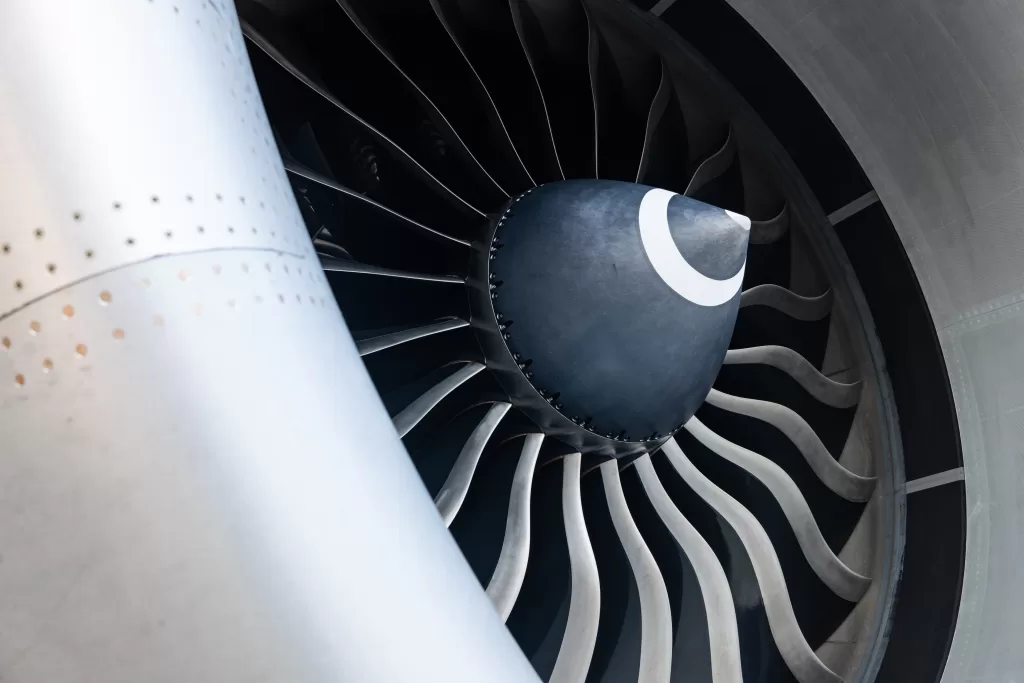Which components in a jet engine use carbon fibre?
The majority of a jet engine’s weight is in the “hot” part of the engine, where the fuel is burned. In these areas, temperatures far exceed the safe operating temperatures for carbon fibre reinforced plastics. For this reason, CFRPs are limited to the “cold” parts of the engine, where they will not be prematurely weakened by the heat of the engine. So, the main areas for CFRPs are in the massive front fan blades that modern jet engines use to move the majority of the air that passes through an engine, along with the exterior casing of the engine, called the nacelle. They are also used in smaller components in engines, like cold air ducts.
Research is being done to incorporate carbon fibres into non-plastic matrix composites, in order to withstand much higher temperatures. This could lead to carbon fibres being used in the “hot” part of the engine, where temperatures regularly exceed 1000°C. One option being looked at is a carbon fibre reinforced silicon carbide matrix composite.
What are the benefits of using carbon fibre in jet engines?
Blades
Carbon fibre composites are used in fan blades because they are lightweight and have a high tensile strength. This allows engineers to design larger fans, which improves engine efficiency. Efficiency improvements in jet engines largely hinge on the ability to increase the size of the front fan relative to the internal “hot” part of the engine. Advances also mean that newer generations of carbon fibre fan blades can be made even thinner and spaced further apart, making them yet more efficient.
Nacelles
When damaged, fan blades can break off the central turbine at extremely high speeds and risk piercing the fuselage or wing. To prevent this, nacelles have to be designed to contain the blades and any other debris. For a long time, this meant that the only suitable material for the nacelle was metal, but carbon fibre composites have become increasingly common. The weight and strength advantages of carbon fibre mean that nacelles can be designed to withstand the ever-growing fan blades. Larger and more efficient fan blades would not be safe without the stronger nacelles.
Carbon fibre is also allowing engineers to think creatively for future generations of aircraft engines. CFM, a collaboration between General Electric and Safran, is working on a new concept of engine where a large carbon fibre fan is on the outside of the engine, while operating at much faster speeds than traditional propeller engines, and more efficiently than traditional jet engines. This engine could be seen on short-haul passenger aircraft in the next decade.
How are carbon fibre components in jet engines manufactured?
Carbon fibre fan blades are made with a variety of methods. The first commercial jet engine to use carbon fibre fan blades was the GE90, which powers the Boeing 777, one of the largest commercial aircraft in operation. The carbon fibre pre-preg fabric for these blades was laid by hand, taking 340 hours to process each blade. Newer generations of carbon fibre fan blades use more efficient methods, like 3D-woven preforms, and resin transfer moulding (RTM), where dry fabric is placed in a mould and injected with resin.
Carbon fibre jet engine nacelles are made using automated processes called automated tape laying (ATL) and automated fibre placement (AFP). These wrap a mould of the engine in carbon fibre prepregs, that are then cured. The most important part of this is the casing around the front fan, which needs to be able to contain the fan blades in the case of a catastrophic failure.
Which aircraft have carbon fibre components in their jet engines?
Many aircraft engines over the last few decades have included carbon fibre components, and it is only becoming more popular. Long-haul aircraft have used carbon fibre in their jet engines since early Boeing 777s started carrying passengers in the mid-1990s. Newer aircraft like the Boeing 787 Dreamliner and the most recent versions of the Airbus A320 and Boeing 737 Max series of aircraft all take advantage of carbon fibre in their engines to increase fuel efficiency and decrease noise. Next time you’re in a plane and notice how quiet the plane is, you can probably thank carbon fibre, at least in part.
Are there any limitations to using carbon fibre in jet engines?
Jet engines often ingest debris like ice, sand, and birds, which can cause catastrophic damage to an engine in the wrong circumstances. Carbon fibre fan blades can be particularly susceptible to this debris, so other materials are used on the leading and trailing edges of the blades that let them dissipate the energy of the debris safely. Titanium or steel are used on the leading edges of fan blades, while glass fibre composites are used on the trailing edges for their flexibility and ability to absorb the energy of an impact.


